Essential Guide to Marketing to Different Generations in E-commerce

Let me ask you something.
Do you have the same exact interests and tendencies as your parents?
Probably not, right?
You’re probably more inclined to use your mobile phone to shop.
And they might have different tastes in social media than you.
You see, people of different age groups will also differ in how they interact with marketing communications.
We’re all products of our environment—so a 30-something millennial grew up in a very different environment than a 67-year-old baby boomer.
If your e-commerce business is marketing to different generations, then you need to know how they compare and contrast.
For this resource, I’m going to break down four generations:
- Gen Z
- Millennials
- Gen X
- Baby Boomers
And for each generation, I’ll specifically tell you their preference for 4 areas of marketing:
- Personalization
- Mobile
- Social Media
Okay, ready to do this?
First, let’s define who each generation is:
Defining Each Generation
Gen Z
Gen Zers, also called centennials, are the youngest and most tech-savvy age cohort in the United States—born between 1997 and 2012.
According to Statista, they make up 20.35% of the US population—or roughly 68 million people.
And Gen Zers are the most diverse generation, with non-Latino Whites comprising only 52%, as per Pew Research Center.
Millennials
Also called Gen Y, millennials were born between 1981 and 1996.
22% of the US population are millennials—or about 73 million.

Many of them have started young families while others are still living out the bachelor lifestyle before finally settling down.
Just like Gen Zers, millennials love online-centric buying experiences.
According to J.D. Power Banking, millennials are over twice as likely to use mobile wallets than older generations.
Gen X
Gen Xers are (usually) the parents of millennials and some Gen Zers.
And they were born between 1965 and 1980.
Currently, there are about 65 million of them residing in the US.
Although they grew up in a different time than their children, Gen Xers have embraced technology. Not only do they love Facebook, they’ll also use the internet to research businesses.
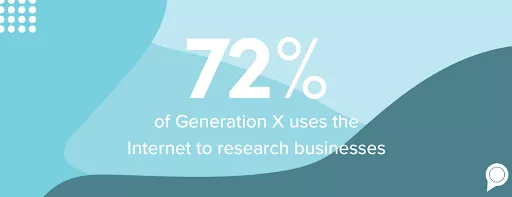
And something worth noting, Gen Xers are at the peak of their careers.
So they can afford more expensive products and services compared to younger generations.
Baby Boomers
Baby boomers, born between 1946 and 1964, are the most resistant to digital marketing.
Comprising 21.45% of the US population, they prefer more traditional shopping experiences—they want a human touch.
Although, COVID-19 has definitely opened their eyes to online shopping.
According to The Washington Post, they spent 49% more on digital purchases in 2020 than they did in 2019.
As for what they spend their money on, Yahoo Finance has some insights.
Baby boomers spend the greatest percentage of their income (14%) on utilities and housing.
And they also spend the most on healthcare (9.5%).

Now let’s start off with marketing to Gen Z.
Marketing to Different Generations in E-commerce: Gen Z
1. Personalization
According to Data Axle, 87% of Gen Z consumers want personalization from brands they are loyal to.
But how does that break down by industry?
When asked what industry they wanted personalized messaging from, 57% said the entertainment industry.
And the rest…
- 53.1% for food and beverage
- 43% for beauty
- 38.3% for consumer electronics
- 32.8% for retail
- 25.8% for hospitality and travel
One thing is clear. You must tailor your marketing messages to the liking of your Gen Z audience.
Because it’s a basic expectation of theirs at this point.
2. Email Usage
58% of Gen Zers check their email multiple times per day, as reported by Campaign Monitor.
In view of this, you can’t forget to optimize your email campaigns for Gen Z.
However, you might not want to send emails to Gen Z as often as your other newsletter subscribers.
That’s because nearly 6 out of 10 of them only want to receive an email from you 1-2 times a week.

When you email marketing to different generations, you also might want to think about how engaged your consumers will be.
For example, Gen Zers have incredibly short attention spans. Some say about 8 seconds.
That means your subject lines must be creative to grab their attention.
3. Mobile
When Criteo surveyed thousands of Gen Z consumers across the globe, they found that 32% of all their transactions take place on mobile.
Yet according to Federal Reserve Economic Data, e-commerce transactions only make up 13.3% of total sales. And that includes desktop and tablet transactions in addition to mobile.
So clearly Gen Z is destined to shift the way business is done.
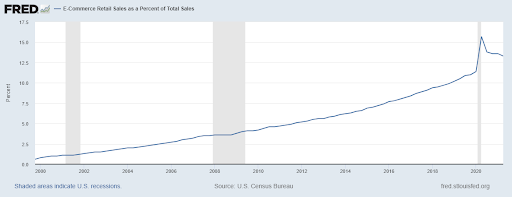
Knowing this preference, it’s important to optimize sales pages for mobile when targeting Gen Z.
All too often, marketing teams assume purchases on sales pages are usually done on desktop.
And while this is true for some industries, such as B2B, Gen Z consumers are mobile-first.
Remember that 68% of Gen Zers will also do some research on their phone before going to your physical store too, according to augmented reality platform, Threekit.
So either way, Gen Z requires special attention to mobile-friendliness.
4. Social Media
It’s no secret that social media is widely popular among Gen Zers.
But did you know how useful it is for them when it comes to shopping?
In its “Status of Social Commerce Report 2021,” The Influencer Marketing Factory found that 97% of Gen Z consumers use social media as their top source of shopping ideas.
And 9 out of 10 Gen Zers have TikTok and Snapchat installed on their smartphones, as per Business of Apps.

When your marketing campaign is targeting Gen Z, make sure that you are actively engaging with them on these social media platforms.
Keep in mind that Gen Zers generally don’t use Facebook and Twitter all that much.
So those two apps might not be worth as much effort as TikTok, Instagram, YouTube, and Snapchat.
And for Instagram, make sure that you’re using all the right KPIs for your posts and stories.
Marketing to Different Generations in E-commerce: Millennials
1. Personalization
According to a SmarterHQ whitepaper, 70% millennials are willing to share personal information in exchange for a more personalized shopping experience.
And brand loyalty increases by roughly 28% when millennials receive personalized marketing communications.
Just like Gen Z, millennials have been a little spoiled with their shopping lives—they have mostly been accustomed to seeing content that resonates with them.
So if your e-commerce business is marketing to different generations, you’ll be doomed for bankruptcy if you can’t keep up with the demand of the future leaders in purchasing power.
2. Email
Marketing technology company, Bluecore, issued a report on consumer engagement this year and found some interesting tidbits of information.
According to its report, 64% of millennials think email is the most personal channel for consumer-brand communication.
And 53% of them are checking out their promotions tab at least once a day.

With these insights, it’s a good idea to offer discounts to your millennial audience via email.
That way, you have a better chance of getting more clicks.
And just like Gen Z, millennials tend to have short attention spans too—around 12 seconds.
Again, you need to get extra creative when sending out emails to this demographic if you want them to read your messages.
3. Mobile
About half of millennials have shopping apps downloaded on their phones, according to Forbes.
And 54% of those that do say they downloaded it for ease of use.
Moreover, 27% of them download retail apps for exclusive offers.
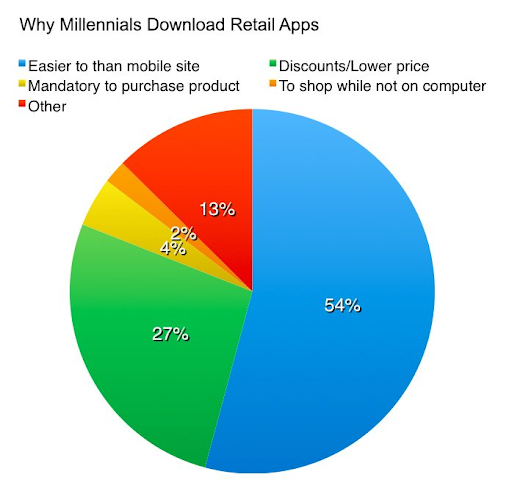
These stats tell us two things about millennials:
- They want a convenient shopping experience: make sure your company abides by the Law of Friction. Allow millennial consumers to make purchases quickly via a user-friendly checkout on mobile.
- Discounts attract millennials: 1 out of 4 millennials are willing to download an app just to receive an exclusive offer.
4. Social Media
As reported by Digimind, 54% of millennials would accept the opportunity to become an influencer.
And 86% of them would be willing to post sponsored content in exchange for money.
What these two stats on the millennial demographic tell you is that you have a huge pool of potential brand advocates.
So it won’t be difficult to find someone to praise your company.
Marketing to Different Generations in E-commerce: Gen X
1. Personalization
When MarTech Advisor surveyed millennial and Gen X consumers, it was revealed that 75% of them expect that all digital marketing communication will be catered towards their own preference.
Although millennials were included, it still shows Gen X cares about personalization too.
Otherwise, you’d see the total percentage be much lower.
With that, you must avoid using cookie-cutter messaging with Gen X.
Instead, tap into all the data at your disposal and greet them with relevant ads, emails, SMS, dynamic landing pages, and whatever else you can think of to prove you care about their individuality.
And since 50% of Gen Xers are brand loyal, according to eMarketer, it’s best to get on their good side.
2. Email
As you’re marketing to different generations, keep in mind that Gen X email users care about ease of transaction the most.
More precisely, 92% of Gen Xers state that ease of transaction is an influential factor in their email purchases, according to MarketingProfs.

This means that when you send emails to Gen X, it must be as easy as possible to check out.
Look at the email promotion below from restaurant chain Papa Murphy’s.
See how the use of color contrast makes it clear where to place an order?
And the imagery is fun and inviting to a younger consumer.
It’s the little things like that can make or break your marketing effectiveness with Gen X.

3. Mobile
Now, we already know that Gen Z and millennials use their phones more than any other generations.
But Gen X isn’t too far behind them.
Even though Gen X grew up without the mass adoption of smartphones and other technology, they have embraced it to a great extent.
According to comparison website, WhistleOut, Gen Xers spend 3 hours per day on their phone. Or 16.5% of their waking hours.
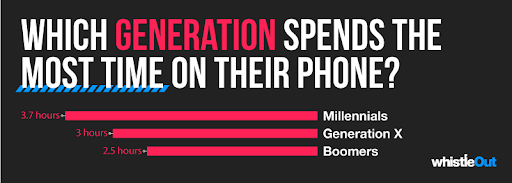
If you target Gen X, then your site needs to be mobile-friendly.
- Is the webpage’s text easy to read on mobile?
- Do your pages fit the screen?
- Does your site load quickly on mobile devices?
The same principles can be applied to email marketing.
According to the previously referenced study from MarketingProfs, 77% of Gen Xers say that mobile-friendliness is an important factor for email purchases.
4. Social Media
According to Sprout Social’s survey results, 29% of Gen X respondents said they plan to increase their social media usage.
But what platforms can you find them on?
Facebook and YouTube are by and far the most popular social media apps used by Gen X—with 76% of them using Facebook and 70% using YouTube, as reported by Statista.
And as for the type of content they prefer?
It’s definitely nostalgia.
Google says that 75% of Gen Xers watch YouTube videos related to past events or people.
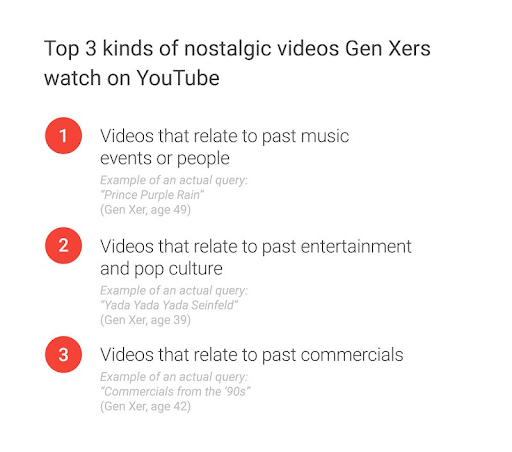
I guess when Liberty Mutual says, “research shows people remember commercials with nostalgia,” they were referring to Gen Xers in particular.

Marketing to Different Generations in E-commerce: Baby Boomers
1. Personalization
It appears to be a pattern that every generation desires personalization.
Which is no surprise because consumer demand evolves as technology delivers better marketing experiences.
In its “Shifts in Marketing Preferences by Generation” report, Data Axel finds that 77% of baby boomers want personalization from brands.
And the food and beverage and retail industries are the top areas where boomers want personalization from the most.
But be careful with retargeting ads. Boomers are more wary of information collection.
In fact, they’re 8% more likely to be concerned about data collection than other generations, according to audience targeting company, GWI.
2. Email
According to Forbes, 95% of baby boomers use email.
But about 8 out of 10 of them prefer to make purchases in physical stores, as per research firm, IntelliShop.
What this means is that baby boomers want a human touch to their purchasing experiences.
Traditional email prmotions might not work with them.
For example, if you sell B2B products online, you’ve probably dealt with many baby boomer decision makers—since they have more seniority in their companies.
Instead of trying to get them to sign up for a free trial through a click of the button, make the call to action a consultation call. Or invite them to a live demo.
You see, the idea is to add a face (or voice) to the customer experience for baby boomers.
Below is an email that a baby boomer would be more likely to engage with due to its promise of a human touch.
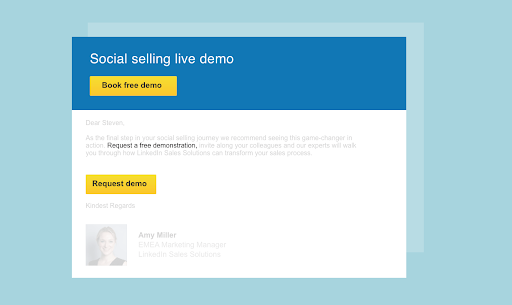
3. Mobile
In Q2 of 2019, just 42% of baby boomers perceived mobile to be their most important device, according to GWI.
But fast forward a bit to 2021, and that number is 53%, taking over the PC, laptop, and tablet category.
And the COVID-19 pandemic likely increased boomers’ preference toward mobile devices, as they were stuck at home.
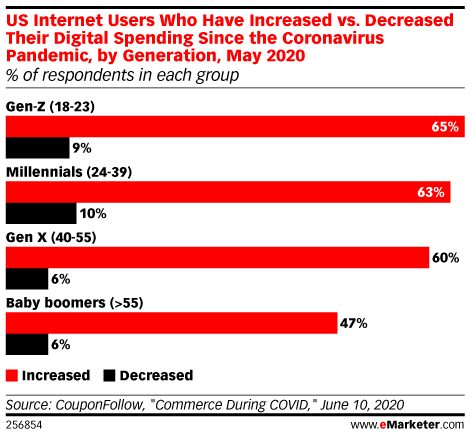
Even though baby boomers are the least likely of all generations to engage with mobile shopping, 52% of them still use apps for researching new products and services, according to Marketing Dive.
So when you’re marketing to different generations, try to remember that baby boomers will still be influenced through mobile.
4. Social Media
When you think of social media marketing, it’s hard not to think of influencers.
And the influencer marketing industry is worth $13.8B, as per Statista.
But baby boomers aren’t into influencers at all.
According to Shopify, just 9% of boomers are persuaded by influencers or experts.
That’s 7% less than Gen X, 14% less than millennials, and 19% less than Gen Z.
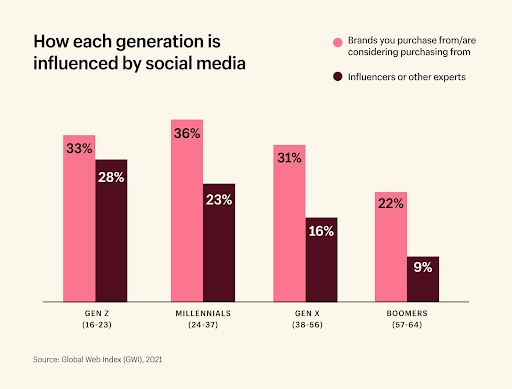
With this insight, it’s probably best to not even bother with reaching out to influencers when targeting baby boomers.
As for the most popular apps used by this generation, YouTube and Facebook lead the way—much like with Gen X.
According to Statista, 67% of baby boomers use YouTube.
And 78% use Facebook, which is above the average across all ages 15+.
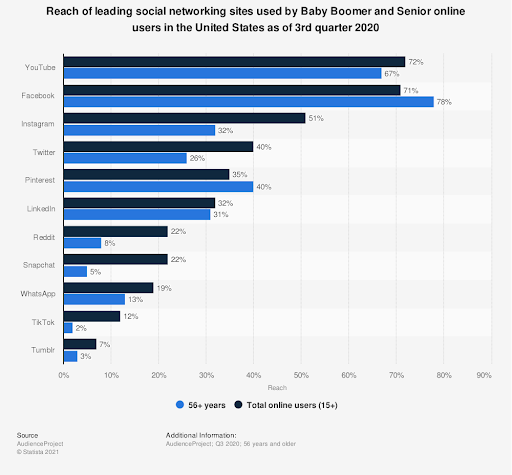
Conclusion
For this resource, we looked at four generations for your ec-commerce business to market to:
- Gen Z
- Millennials
- Gen X
- Baby Boomers
When you’re marketing to different generations, you must be aware of the differences between them.
But as you read, you probably picked up on some of the similarities too —such as a preference for personalization. And the popular use of email.
As you compare and contrast the different generations, you can tailor your marketing communications for each segment—and sometimes you may be able to simply use the same tactics.
At AutoGrow, we’ve carried out marketing campaigns targeting all generations.
Using our digital marketing expertise, we’ll strategize what content will convert your target audience and choose the channels where they can be found.
And the best part is, all you have to do is delegate a project to us — and you can watch the progress unfold in no time.
Just choose a package that fits your needs and budget.
And before you leave,
Did you learn anything new?
Let me know in the comments below.
Keep AutoGrowin’, stay focused.
Mark

















